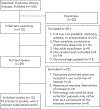Systematic Review of Randomized Controlled Trials of Exercise Interventions Using Digital Activity Trackers in Patients With Cancer
- PMID: 30659130
- PMCID: PMC6519727
- DOI: 10.6004/jnccn.2018.7082
Systematic Review of Randomized Controlled Trials of Exercise Interventions Using Digital Activity Trackers in Patients With Cancer
Abstract
Background: Exercise can ameliorate cancer- and treatment-related toxicities, but poor adherence to exercise regimens is a barrier. Exercise interventions using digital activity trackers (E-DATs) may improve exercise adherence, but data are limited for patients with cancer. We conducted a systematic review examining the feasibility of E-DATs in cancer survivors and effects on activity level, body composition, objective fitness outcomes, health-related quality of life (HRQoL), self-reported symptoms, and biomarkers. Methods: We identified randomized controlled trials (RCTs) of E-DATs in adult cancer survivors published in English between January 1, 2008, and July 27, 2017. Two authors independently reviewed article titles (n=160), removed duplicates (n=50), and reviewed the remaining 110 articles for eligibility. Results: A total of 12 RCTs met eligibility criteria, including 1,450 patients (mean age, 50-70 years) with the following cancers: breast (n=5), colon or breast (n=2), prostate (n=1), acute leukemia (n=1), or others (n=3). Duration of E-DATs ranged from 4 to 24 weeks, and the follow-up period ranged from 4 to 52 weeks, with retention rates of 54% to 95%. The technology component of E-DATs included pedometers (n=8); pedometers with smartphone application (n=1), Wii Fit (n=1), heart rate monitor (n=1); and a wireless sensor with accelerometer, gyroscope, and magnetometer (n=1). Adherence by at least one measure to E-DATs was >70% in 8 of 8 RCTs. Compared with controls, E-DATs significantly improved patients' step count in 3 of 5 RCTs, activity level in 6 of 9 RCTs, and HRQoL in 7 of 9 RCTs (all P≤05), with no significant changes in biomarkers (eg, interleukin 6, tumor necrosis factor α, C-reactive protein, c-peptide, lipid panel) in 3 RCTs. Duration of E-DAT was not significantly correlated with adherence or study retention. Conclusions: This systematic review shows that E-DATs are feasible to implement in cancer survivors. Future research should examine the optimal type, dose, and schedule of E-DATs for cancer survivors.
Copyright © 2019 by the National Comprehensive Cancer Network.
References
Publication types
MeSH terms
Grants and funding
LinkOut - more resources
Full Text Sources
Medical
Research Materials
Miscellaneous


